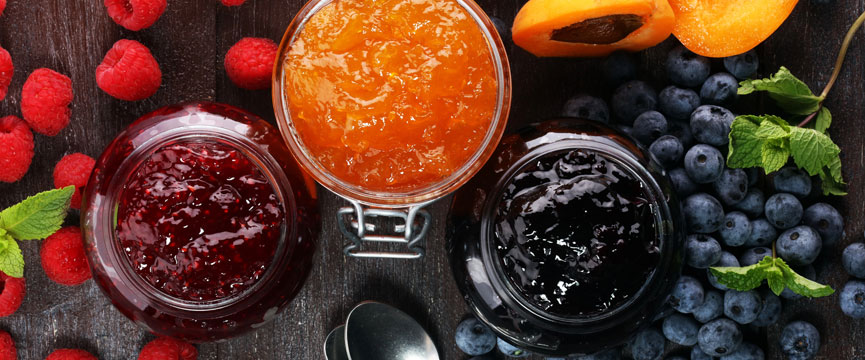 The fruit jam industry is a dynamic and constantly evolving segment worldwide. For industry professionals, understanding consumer preferences and emerging trends is essential to optimize their offerings and meet customer demands. The global jam market represents an industry valued at over $8.5 billion, with projected sustained growth of 3.8% annually until 2028.
The fruit jam industry is a dynamic and constantly evolving segment worldwide. For industry professionals, understanding consumer preferences and emerging trends is essential to optimize their offerings and meet customer demands. The global jam market represents an industry valued at over $8.5 billion, with projected sustained growth of 3.8% annually until 2028.

In this post, we’ll take a comprehensive look at which jams dominate the global market, the regional differences, and the opportunities these trends represent for any HORECA establishment. Stay with us if you’d like to know the most consumed fruit jam.
Table of Contents
What is the leading fruit jam in the global market?
Strawberry jam maintains its undisputed dominance in the global market with a market share of approximately 30%. Its familiar flavor, versatility in sweet and savory applications, and visual appeal make it a favorite among consumers as well as chefs and pastry chefs. Let’s examine the factors that support this leadership:
- Worldwide availability: Strawberries are grown on every continent. Jam also comes in a variety of formats, from industrial to artisanal.
- Versatile flavor profile: This jam presents a perfect balance between sweetness and acidity, which is why it is so attractive to a wide segment of consumers.
- Cultural recognition: It is present in the gastronomy of practically all countries.
- Multiple applications: It is one of the most used ingredients in breakfasts, desserts and pastries.
Strawberry jam is the leader, but other varieties also have significant market shares:
- Apricot jam: Widely consumed in Europe, especially in Germany and Austria.
- Bitter orange marmalade: Predominant in the United Kingdom, particularly as a “marmalade” for breakfast with toast and tea.
Why do professionals use strawberry jam more?
For professionals, strawberry jam offers several very important advantages for their creations. Let’s take a look at them below:
- Guaranteed rotation: This means a lower risk of inventory becoming obsolete.
- Multiple applications: It is used from buffet breakfasts to fine pastries.
- Almost everyone likes it: There is minimal rejection of strawberry jam by the final consumer.
Analysis of fruit jam consumption by professional sectors
Hotel and restaurant sector
Hotels consume more than 1.2 million tons of jam annually worldwide. They prefer single-serve jams, with strawberry being the most popular, followed by apricot and orange. Let’s take a closer look at jam consumption in hotels:
- 5-star hotels: Artisanal jams with 65% fruit.
- Business hotels: Single doses of 20 to 30 grams, mainly strawberry and apricot.
- Tourist resorts: Local and exotic varieties (mango, passion fruit).
- Restaurants: They often opt for artisanal and locally produced jams to highlight their breakfast and brunch menus.
Fruit jam in Bakeries and pastry shops
This sector represents 42% of professional consumption worldwide:
- Bakeries: They use high-quality jams for fillings and toppings. Strawberry and berry jams are their favorites.
- Gourmet pastries: They prefer unique and premium varieties for their exclusive products.
Retail sector
In the professional retail sector, trends are moving towards healthy:
- Low sugar jams: Consumption of this type of jam continues to increase in response to the demand for healthier products.
- Organic jams: The growth of this segment reflects the interest in more natural and sustainable products.
Fruit jam consumption by geographical area
Europe
- United Kingdom: Bitter orange marmalade holds a special place in the traditional British breakfast, hence its widespread consumption, with a 35% market share and per capita consumption of 1.2 kg/year. Growth in the premium segment is increasing by 8% annually.
- France: Strawberry jam accounts for almost 25% of total jam sales. Apricot and raspberry jam follow. The tradition of a “petit déjeuner” (small breakfast) with bread and jam is still very much alive. However, the regulations are very strict, as a minimum of 55% fruit is required.
- Spain: Tomato jam is growing by 12% in the hospitality industry and citrus jams account for 20% of the market, although strawberry jam remains the undisputed leader with 85.8%, followed by peach jam (4.7%), pineapple (4.7%), exotic flavors (4.2%) and blackberry (2.3%).
- Germany and Austria: In these countries, they prefer apricot jam and berries, such as blueberries or currants. As in France, the regulations are very strict and require a high fruit content, often exceeding 50%.
Fruit jam in America
- USA: Although strawberry jam leads the way, grape jelly is also very popular due to its use in peanut butter and jelly sandwiches:
- Grape jelly: 30% of the market.
- Strawberry jam: 25% of the market.
- Squeeze format (dispenser): 18% growth.
- Brazil: Tropical fruit jams such as guava (40% of the national market) and passion fruit are widely consumed in this country due to the abundance of these fruits. Exports of these products to Europe are growing significantly.
Fruit jams in Asia-Pacific
- Japan: Exotic varieties like yuzu are growing rapidly, especially in premium niches, due to their uniqueness and sophistication. Meanwhile, European jam imports exceed 15% annually.
- China The jam market in China continues to expand, growing at 25% annually. Chinese people prefer less sweet, more natural flavors.
Fruit jam trends that transform the market
These are the current jam trends among chefs and bakers:
Flavors
The introduction of innovative and exotic flavors is a growing trend these days. Jams with different combinations, such as strawberry and basil or mango and chili, are becoming increasingly popular.
Sustainability
- Recyclable packaging: This is a growing demand in the Horeca sector.
- Fair trade: It is highly valued in boutique hotels.
- Local production: “zero-mile products” trend.
Fruit jam premium products
The premium segment is growing 12% annually. These are some of the products that are on the rise:
- Signature jams.
- Seasonal limited editions.
- Innovative gastronomic pairings.
- Jams with chunky fruit: 15% annual growth.
- Premium red berries jams: demand is growing in the gourmet baking industry.
Advantages for professionals of using fruit jam
For professionals, a detailed knowledge of the jam market allows them to:
- Inventory Optimization: adjust your stock according to actual demand.
- Competitive differentiation: offer jams that are in trend.
- Loyalty: anticipate customer needs.
As we can see, fruit jam is not just a complement for chefs, bakers, and pastry chefs; it’s a strategic product that, when well selected, can increase customer satisfaction and business margins. The key is choosing suppliers that offer consistent quality guarantees, a broad catalog tailored to the market, and good ongoing support for professionals.
At Lazaya Preserved Fruits we love providing professionals with the best products, including the most popular jam, tailored to their needs and market trends. Take a look at our catalog and contact us for everything you need. Shall we talk?





